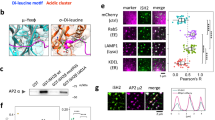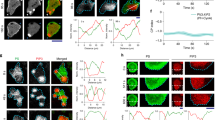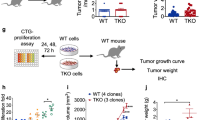Abstract
Cancer progression is associated with enhanced directional cell migration, both of the tumour cells invading into the stroma and stromal cells infiltrating the tumour site. In cell-based assays to study directional cell migration, phorbol esters are frequently used as a chemotactic agent. However, the molecular mechanism by which these activators of protein kinase C (PKC) result in the establishment of a polarized migratory phenotype is not known. Here we show that CD44 expression is essential for chemotaxis towards a phorbol ester gradient. In an investigation of CD44 phosphorylation kinetics in resting and stimulated cells, Ser316 was identified as a novel site of phosphorylation following activation of PKC. PKC does not phosphorylate Ser316 directly, but rather mediates the activation of downstream Ser316 kinase(s). In transfection studies, a phosphorylation-deficient Ser316 mutant was shown to act in a dominant-negative fashion to impair chemotaxis mediated by endogenous CD44 in response to a phorbol ester gradient. Importantly, this mutation had no effect on random cell motility or the ability of cells to migrate directionally towards a cocktail of chemoattractants. These studies demonstrate that CD44 functions to provide directional cues to migrating cells without affecting the motility apparatus.
This is a preview of subscription content, access via your institution
Access options
Subscribe to this journal
Receive 50 print issues and online access
$259.00 per year
only $5.18 per issue
Buy this article
- Purchase on Springer Link
- Instant access to full article PDF
Prices may be subject to local taxes which are calculated during checkout







Similar content being viewed by others
References
Allen WE, Zicha D, Ridley AJ, Jones GE . (1998). J Cell Biol 141: 1147–1157.
Alstergren P, Zhu B, Glougauer M, Mak TW, Ellen RP, Sodek J . (2004). Cell Immunol 231: 146–157.
Avigdor A, Goichberg P, Shivtiel S, Dar A, Peled A, Samira S et al. (2004). Blood 103: 2981–2989.
Balkwill F . (2004). Nat Rev Cancer 4: 540–550.
Bourguignon LY, Singleton PA, Zhu H, Diedrich F . (2003). J Biol Chem 278: 29420–29434.
Caloca MJ, Garcia-Bermejo ML, Blumberg PM, Lewin NE, Kremmer E, Mischak H et al. (1999). Proc Natl Acad Sci USA 96: 11854–11859.
Camp RL, Kraus TA, Pure E . (1991). J Cell Biol 115: 1283–1292.
Chijiwa T, Mishima A, Hagiwara M, Sano M, Hayashi K, Inoue T et al. (1990). J Biol Chem 265: 5267–5272.
Cichy J, Kulig P, Pure E . (2005). Biochim Biophys Acta 1745: 59–64.
Davies SP, Reddy H, Caivano M, Cohen P . (2000). Biochem J 351: 95–105.
Deak M, Clifton AD, Lucocq LM, Alessi DR . (1998). EMBO J 17: 4426–4441.
Dingemans KP, Ramkema MD, Pals ST . (2002). Lab Invest 82: 313–322.
Draffin JE, McFarlane S, Hill A, Johnston PG, Waugh DJ . (2004). Cancer Res 64: 5702–5711.
Dransfield DT, Bradford AJ, Smith J, Martin M, Roy C, Mangeat PH et al. (1997). EMBO J 16: 35–43.
Ebinu JO, Bottorff DA, Chan EY, Stang SL, Dunn RJ, Stone JC . (1998). Science 280: 1082–1086.
Eccles SA . (2005). Curr Opin Genet Dev 15: 77–86.
El-Shemerly MY, Besser D, Nagasawa M, Nagamine Y . (1997). J Biol Chem 272: 30599–30602.
Estensen RD, Hill HR, Quie PG, Gogan N, Goldberg ND . (1973). Nature 245: 458–460.
Favata MF, Horiuchi KY, Manos EJ, Daulerio AJ, Stradley DA, Feeser WS et al. (1998). J Biol Chem 273: 18623–18632.
Fujisaki T, Tanaka Y, Fujii K, Mine S, Saito K, Yamada S et al. (1999). Cancer Res 59: 4427–4434.
Glass DB, Lundquist LJ, Katz BM, Walsh DA . (1989). J Biol Chem 264: 14579–14584.
Gomez-Mouton C, Lacalle RA, Mira E, Jimenez-Baranda S, Barber DF, Carrera AC et al. (2004). J Cell Biol 164: 759–768.
Herrera-Gayol A, Jothy S . (1999). Exp Mol Pathol 66: 99–108.
Herrera-Gayol A, Jothy S . (2001). Int J Exp Pathol 82: 193–200.
Isacke CM, Sauvage CA, Hyman R, Lesley J, Schulte R, Trowbridge IS . (1986). Immunogenetics 23: 326–332.
Jones GE . (2000). J Leukoc Biol 68: 593–602.
Kalomiris EL, Bourguignon LY . (1989). J Biol Chem 264: 8113–8119.
Kim HR, Wheeler MA, Wilson CM, Iida J, Eng D, Simpson MA et al. (2004). Cancer Res 64: 4569–4576.
Kobayashi H, Suzuki M, Kanayama N, Nishida T, Takigawa M, Terao T . (2002). Int J Cancer 102: 379–389.
Legg JW, Isacke CM . (1998). Curr Biol 8: 705–708.
Legg JW, Lewis CA, Parsons M, Ng T, Isacke CM . (2002). Nat Cell Biol 4: 399–407.
Lewis CA, Townsend PA, Isacke CM . (2001). Biochem J 357: 843–850.
Liu WS, Heckman CA . (1998). Cell Signal 10: 529–542.
Martin TA, Harrison G, Mansel RE, Jiang WG . (2003). Crit Rev Oncol Hematol 46: 165–186.
Miletti-Gonzalez KE, Chen S, Muthukumaran N, Saglimbeni GN, Wu X, Yang J et al. (2005). Cancer Res 65: 6660–6667.
Mine S, Fujisaki T, Kawahara C, Tabata T, Iida T, Yasuda M et al. (2003). Exp Cell Res 288: 189–197.
Nagano O, Murakami D, Hartmann D, De Strooper B, Saftig P, Iwatsubo T et al. (2004). J Cell Biol 165: 893–902.
Neame SJ, Isacke CM . (1992). EMBO J 11: 4733–4738.
Neame SJ, Isacke CM . (1993). J Cell Biol 121: 1299–1310.
Neame SJ, Uff CR, Sheikh H, Wheatley SC, Isacke CM . (1995). J Cell Sci 108: 3127–3135.
Pearson RB, Kemp BE . (1991). Methods Enzymol 200: 62–81.
Peck D, Isacke CM . (1996). Curr Biol 6: 884–890.
Peck D, Isacke CM . (1998). J Cell Sci 111: 1595–1601.
Perschl A, Lesley J, English N, Hyman R, Trowbridge IS . (1995). J Cell Sci 108: 1033–1041.
Ponta H, Sherman L, Herrlich PA . (2003). Nat Rev Mol Cell Biol 4: 33–45.
Pure E, Camp RL, Peritt D, Panettieri Jr RA, Lazaar AL, Nayak S . (1995). J Exp Med 181: 55–62.
Pure E, Cuff CA . (2001). Trends Mol Med 7: 213–221.
Ratliff TL . (2005). J Urol 173: 1045.
Sim AT, Scott JD . (1999). Cell Calcium 26: 209–217.
Thorne RF, Legg JW, Isacke CM . (2004). J Cell Sci 117: 373–380.
Toullec D, Pianetti P, Coste H, Bellevergue P, Grand-Perret T, Ajakane M et al. (1991). J Biol Chem 266: 15771–15781.
Trowbridge IS, Lesley J, Schulte R, Hyman R, Trotter J . (1982). Immunogenetics 15: 299–312.
Turley EA, Noble PW, Bourguignon LY . (2002). J Biol Chem 277: 4589–4592.
Tzircotis G, Thorne RF, Isacke CM . (2005). J Cell Sci 118: 5119–5128.
Van Haastert PJ, Devreotes PN . (2004). Nat Rev Mol Cell Biol 5: 626–634.
Van Lint J, Rykx A, Maeda Y, Vantus T, Sturany S, Malhotra V et al. (2002). Trends Cell Biol 12: 193–200.
Weber GF, Bronson RT, Ilagan J, Cantor H, Schmits R, Mak TW . (2002). Cancer Res 62: 2281–2286.
Weiner OD . (2002). Curr Opin Cell Biol 14: 196–202.
Xu Y, Yu Q . (2003). J Biol Chem 278: 8661–8668.
Yonemura S, Hirao M, Doi Y, Takahashi N, Kondo T, Tsukita S . (1998). J Cell Biol 140: 885–895.
Zhao Z, Tan Z, Diltz CD, You M, Fischer EH . (1996). J Biol Chem 271: 22251–22255.
Zhu B, Suzuki K, Goldberg HA, Rittling SR, Denhardt DT, McCulloch CA et al. (2004). J Cell Physiol 198: 155–167.
Zhu H, Mitsuhashi N, Klein A, Barsky LW, Weinberg K, Barr ML et al. (2005). Stem Cells 24: 928–935.
Zicha D, Dunn GA, Brown AF . (1991). J Cell Sci 99: 769–775.
Acknowledgements
We thank Daniel Zicha (Cancer Research UK, London Research Institute) for providing us with the Mathematica analysis notebook. We thank Justin Sturge for assistance with the chemotaxis assays, Ian Titley for his help with FACS sorting and Professor Peter Dunkley for his critique of the data and useful suggestions. This research was supported by the Association for International Cancer Research, Breakthrough Breast Cancer and the Biotechnology and Biological Sciences Research Council.
Author information
Authors and Affiliations
Corresponding author
Rights and permissions
About this article
Cite this article
Tzircotis, G., Thorne, R. & Isacke, C. Directional sensing of a phorbol ester gradient requires CD44 and is regulated by CD44 phosphorylation. Oncogene 25, 7401–7410 (2006). https://doi.org/10.1038/sj.onc.1209724
Received:
Revised:
Accepted:
Published:
Issue Date:
DOI: https://doi.org/10.1038/sj.onc.1209724



